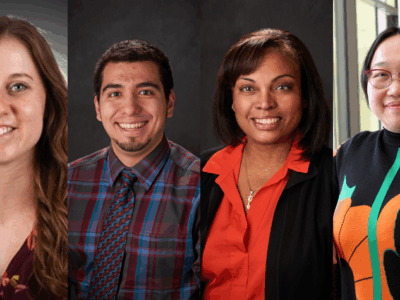
14
September

Assistant Professor Jay Ford collaborates with UW Department of Medicine on grant to enhance and expand telehealth in Wisconsin nursing homes
By Arushi Gupta
When the COVID-19 pandemic hit the United States in early 2020, health practitioners had to convert their nursing home visits from in-person to online seemingly overnight. As the world came to a standstill under quarantine, a team of University of Wisconsin–Madison researchers quickly came to the realization that telehealth is here to stay, and studies into the barriers and opportunities of implementing a telehealth model would benefit a breadth of practitioners and patients.
Chris Crnich, chief of medicine at the William S. Middleton Memorial Veterans Hospital and associate professor of medicine in the Division of Infectious Diseases at the School of Medicine and Public Health, says nursing homes were particularly hit hard by the pandemic
To ensure nursing homes were able to continue providing quality care to residents while keeping the risk of a COVID-19 outbreak low, Crnich proposed a collaborative study with Jay Ford, assistant professor in the University of Wisconsin–Madison School of Pharmacy’s Social and Administrative Sciences Division as well as Elizabeth Chapman and Ann Braus, assistant professors in Geriatrics and Gerontology in the UW Department of Medicine. Their proposal was awarded a 2020 COVID-19 Response Grant Award by the UW Institute for Clinical and Translational Research and the Wisconsin Partnership Program at the UW School of Medicine and Public Health, and the team was able to launch the study immediately.
“Now that telehealth is here, it is not going away. Even with the pending availability of a vaccine, COVID-19 is going to continue to have a big impact on nursing homes,” Crnich says. “We saw this as an opportunity to conduct a somewhat natural experiment that will allow us to identify characteristics and features that will make that workflow more effective and more efficient in nursing homes.”
As the health systems engineer on the project, Ford helped develop the interview guides to understand existing telehealth models in nursing homes (NH) and is involved in interviewing NH staff and providers about the telehealth experience in the NH. In addition, he is involved in researching the usability of technology.
“Ultimately, the technology may change, to quite some extent, how care is provided in nursing homes,” Ford says.
“Ultimately, the technology may change, to quite some extent, how care is provided in nursing homes.”
—Jay Ford
Currently, their pilot study is relying on a sample of four facilities in Dane County, which have operational relationships with health care providers UW–Madison. Researchers will interview providers and NH staff and will be passive observers during telehealth appointments between a provider, facility resident, and telehealth facilitator from the nursing home, who is usually a nurse. After the appointment, the research team will conduct brief interviews with each party to examine the quality of the session.
Initial interviews suggest that there are numerous challenges for nursing homes implementing telehealth visits, mainly for nursing staff who have many responsibilities beyond participating in telehealth sessions.
“It will be interesting to see if there are differences in how facilities have allocated tasks and responsibilities and if that’s leading to an improved work model than what we’re observing right now in our first facility,” Crnich says.
Additional barriers to telehealth include the prevalence of cognitive impairment in residents and the need for the residents’ primary nurse to be present during the telehealth encounter to ensure a smooth and clear flow of information between the patient and the provider.
“We’re learning a lot about information-gathering and how complicated this is in a nursing home environment,” Crnich says. “It’s very different for an encounter between a patient who’s in their home and their provider who is located in an office. Complexity is going to be a very big challenge for this.”
Ford thinks telehealth may help mitigate the logistical challenges of transporting patients between nursing homes and hospitals and clinics for routine appointments and check-ups that don’t need to be in person. Moreover, relying more on telehealth visits reduces the risk of residents bringing infections back into the facility after hospital visits.
“We saw this as an opportunity to conduct a somewhat natural experiment that will allow us to identify characteristics and features that will make that workflow more effective and more efficient in nursing homes.”
—Chris Crnich
“There are various conditions that absolutely require a face-to-face visit, but there’s an awful lot of care that we can conduct virtually with quality decision-making and patient outcomes,” Crnich says.
In addition to examining how feasible telehealth is for nursing homes, Ford is developing a usability survey for nursing homes to try to assess how easy they think it is to use this technology in their day-to-day setting.
“We’re learning that some nursing homes are better for us to talk to about their process because they have a system in place or because they don’t have too many other competing priorities that would make our study a burden,” Ford says.
In order to improve the quality of telehealth, Crnich says he is also looking at provider groups or other health systems to see how they are implementing telehealth.
Because this is a year-long project, the team is aiming to complete preliminary data collection and analysis by December 2020, and finish data analysis within six months. With the complete data, they can put together a model for nursing homes to follow as they implement and improve telehealth services. Their project has the potential to radically alter the delivery of healthcare in nursing homes.
“Nursing homes are under extraordinary circumstances, and we are extraordinarily grateful to them,” Crnich says. “I think they understand that there’s an opportunity here to improve what they’re doing, and they are interested in supporting that.”




